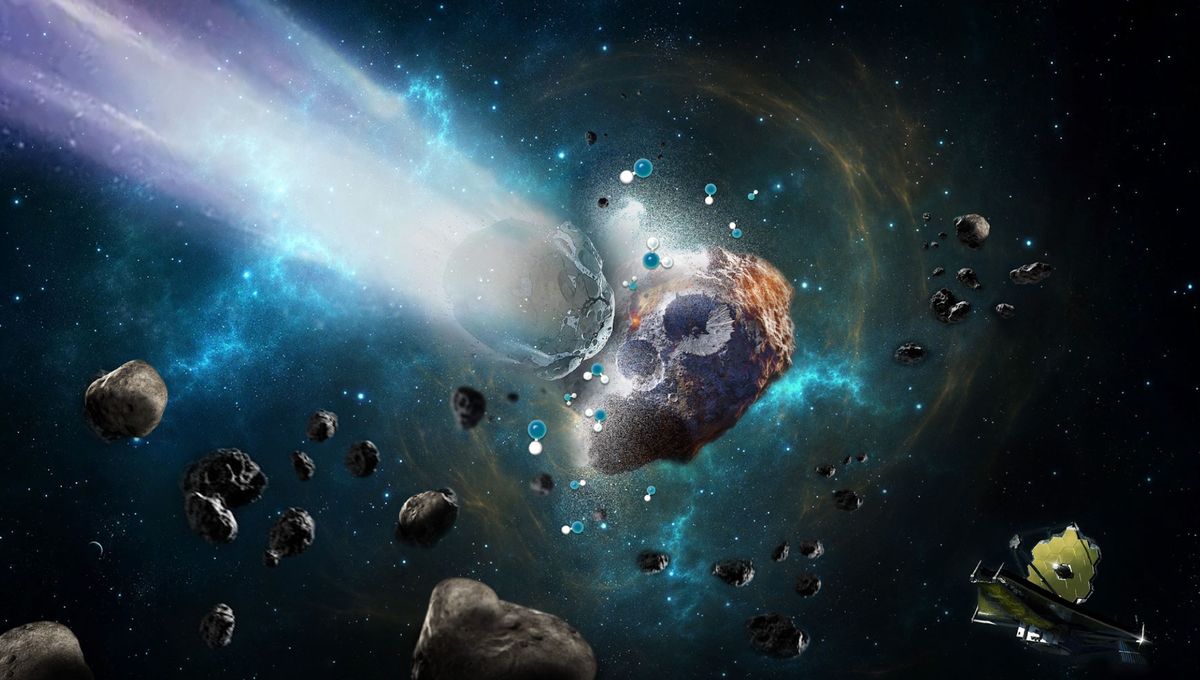
Hydrated metals have been detected on the surface of the asteroid Psyche. The observations, made with JWST, raise some big questions for the mission named after the asteroid, which hopefully will be settled when the spacecraft reaches its target.
At 222 kilometers (178 miles) wide, 16 Psyche is the 16th largest member of the asteroid belt (not the reason for its number), but its importance is greater than that. Where larger counterparts are mostly composed of silicates and carbonates, Psyche is the Solar System’s largest M-type asteroid, the most metal-rich category.
Although expected to be predominantly nickel-iron, Psyche also contains large quantities of precious metals close to the surface. This sometimes leads to absurd headlines listing a value greater than the global economy, forgetting the fact that if we could mine its contents the sudden abundance of these metals would cause prices to crash. Recent re-estimates of Psyche’s density have also cast doubt on just how metal-rich it may be.
Planetary scientists think Psyche’s true gold is the information it can offer, suspecting it is the surviving core of a protoplanet destroyed in a collision with an object of similar size. If so, it could teach us a lot about the cores of surviving inner planets, including our own, although alternative origin stories have also been proposed. The discovery of molecules combining water with metals at its surface could have implications for the source of Earth’s own water.
Using JWST, a team of astronomers led by Dr Stephanie Jarmak, formerly of Southwest Research Institute (SwRI), found Psyche is absorbing light with a wavelength of 3-µm. This wavelength is associated with OH (hydroxyl) components of molecules, either when bonded to metals, or in water. With Psyche being so iron-rich, it is likely much of what was detected is iron hydroxides like Fe(OH)3, familiar as a component of rust.
However, water produces a 6-µm line not seen by JWST or previous observations. Consequently, the authors conclude there cannot be more than 39 parts per million water on Psyche’s surface. That’s pretty dry – the Moon is 100-400 ppm, thought to be from hydrogen brought by the solar wind.
Psyche gets too much sunlight for ice to survive on its surface, but exposed water-bearing minerals are a different matter, along with metals that have reacted with past water.
One explanation for the presence of these hydroxides is that water was brought to Psyche on carbonaceous chondrite asteroids, which are known to carry it. These asteroids are common in the main asteroid belt, and it is to be expected some would collide with Psyche. Whether this happens often enough to account for what has been observed is uncertain, however.
The alternative theory is that Psyche formed beyond the Solar System’s “snow line”, where temperatures are low enough for ice to survive on objects, as seen with the outer planets. How Psyche migrated from there to its current orbit is unknown, but if this version is correct, it must have preserved some water in the process. In this scenario, Psyche is not the left-over core of a protoplanet after all.
This debate mimics the long-standing one about Earth’s water. Was it all brought here by comets and asteroids, or did it survive deep in the mantle when the surface was magma and subsequently escape through volcanoes? If we can answer the question for Psyche, it may help us solve the issue closer to home.
“Our understanding of Solar System evolution is closely tied to interpretations of asteroid composition, particularly the M-class asteroids that contain higher concentrations of metal,” Jarmak said in a statement.
The Psyche mission is almost a third of the way on its journey to check the asteroid out, and will no doubt answer many questions. However, it is not able to measure spectra longer than 1.1 µm. “Using telescopes at different wavelengths of infrared light, the SwRI-led research will provide different but complementary information to what the Psyche spacecraft is designed to study,” said Dr Tracy Becker.
The study is to be published in the Planetary Science Journal and a preprint is available on arXiv.org.
Source Link: JWST Discovers Asteroid Psyche Is Rusting, Suggesting A Complex History